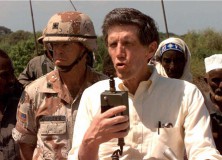Somalia: Did Leaders or the System Fail? — Christopher J. Lamb with Nicholas J. Moon

INTRODUCTION:
In late 1992, the United States intervened in Somalia to prevent fractious warlords from hindering the distribution of international food aid in the midst of widespread drought and economic collapse. U.S. forces performed admirably (as part of UNITAF) and ensured food distribution. After United Nations forces took over (UNOSOM II) and pursued a more ambitious reconstruction agenda, they ran into stiff armed resistance. Following several months of low-level conflict, the United States sent U.S. special operations forces to Somalia to neutralize the most troublesome warlord. The mission ended disastrously on October 3, 1993, when U.S. special operations forces were pinned down in a protracted engagement. After inflicting close to a thousand casualties on the enemy and losing eighteen soldiers, a UN relief force extracted the special operations forces . Shortly thereafter, the U.S. military withdrew from Somalia. The failed intervention had momentous consequences at home and abroad. The Somalia intervention also allows an examination of the U.S. government’s ability to integrate its instruments of national power, as represented by the multiple national security organizations involved.
STRATEGY:
Prior to and during UNITAF’s humanitarian operations, the National Security Council (NSC) operated without a strategy and on an ad hoc basis. The intervention was driven more by the president’s personal feelings than by sober calculations of national interest. The NSC was able to generate alternative courses of action, and to align its objectives with the means necessary to achieve them, but absent a controlling strategy the basic mission and resource issues were addressed in an ad hoc manner. Even so, the senior U.S. civilian and military representatives in Somalia developed a strategy for achieving the Bush Administration’s objectives without exceeding the available resources. By contrast, the Clinton Administration’s formal, coordinated and explicit policy for UNOSOM II was codified in a presidential decision directive that obscured the contradiction between Clinton Administration objectives and resources.
INTEGRATED ELEMENTS OF NATIONAL POWER:
Ambassador Robert Oakley and Lieutenant General Robert B. Johnston judiciously combined diplomacy and military power, never failing to keep open lines of communication and limiting the application of force to that which was necessary to ensure the delivery of aid. They integrated force with civic action and information campaigns to reassure the public that the UNITAF presence was ultimately benign. Unfortunately, the United States was not able to closely integrate the elements of national power well in crafting policy for the follow-on UNOSOM II mission. The interagency decision making system repeatedly failed, both in Washington and in the field. Interagency decision bodies were not able to develop common and iterative assessments of the resources required to execute U.S. policy. Neither could they develop common assessments of risks nor effective risk mitigation plans to hedge against undesirable outcomes.
EVALUATION:
The NSC, as well as other U.S. government assessment and decision making bodies, repeatedly papered over a fundamental mismatch between objectives and resources. Hope was a persistent but poor substitute for clear analysis as the U.S. government stumbled into a high risk, military-centric strategy, ignoring one warning after another that UNOSOM forces and special operations forces could not accomplish their assigned objectives. The decision making system did not respond nimbly to evolving circumstances or effectively coordinate its own policy decisions well, particularly with regards to managing the inherently complex and difficult two-track policy of pursuing military and political initiatives simultaneously. The national security apparatus could only digest and act on this reality slowly and incompletely–and as it turned out, too late to avoid being overtaken by events that should have been assessed as increasingly likely and prepared for accordingly much earlier.
RESULTS:
Washington’s failure to integrate elements of national power effectively produced a debacle that cost the United States a great deal besides lost lives. It created deep policy divisions in Washington and increased tensions between senior civilian and military leaders. Somalia effectively ended the Clinton Administration’s policy of assertive multilateralism and Les Aspin’s short career as Secretary of Defense. The failure disinclined the United States from intervening elsewhere, including in Rwanda where horrific internecine tribal conflict led to mass murder. In addition, the defeat undermined the credibility that the United States had acquired from the successful Gulf War the previous year. Arguably, Somalia also encouraged America’s enemies to challenge U.S. interests. Just as the most powerful Somali warlord bluntly told Ambassador Oakley that American failures in Vietnam and Beirut proved the United States did not have staying power, Osama Bin Laden and others similarly concluded from Somalia and other events that the United States lacked the will to protect its interests.
CONCLUSION:
The United States initially approached the intervention in Somalia with ad hoc decision making, but leaders in the field were able to impose their own strategy and integrate the elements of national power well. As the Clinton Administration took responsibility for the mission, it formally coordinated a strategy that was unclear and which failed to reconcile expansive objectives with limited means. Typical interagency structures and processes were inadequate. They tended to restrict the flow of information and generate compromise rather than clear alternative courses of action. The result was a severe failure with long-term repercussions for U.S. security interests.